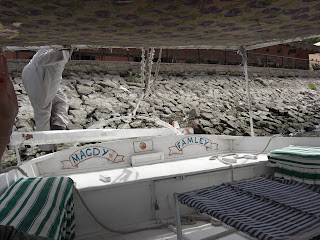After our tour of the Aswan dam, we made our way to Philae Temple. Philae is where the god Osiris was rumored to have been buried, so it was a revered holy site for both Egpytians as well as Nubians from the South.
We made our way to the ruins by boat.

The temple is thought to have been constructed between 282-145BC. Southern Egpyt has a large Nubian population, people who ethnically trace their heritage back from the Sudan and deeper into Africa. The Nubian culture is still present to this day, and for the most part, remains largely separate and distinct. As a result, there are numerous Nubian monuments present at Philae Temple.
The entrance of the temple originally housed two huge obelisks, but like many others, they now sit outside the country, with one in at the Louvre in Paris and one in Florence, Italy.
Like other temples, early Christians would later use it as centers for worship. This site is unique because it still houses one of the original Christian altars.
The site of temple actually sits at a different location because the construction of the Aswan dam flooded the original site.
At the southern end of the ruins is a smaller temple dedicated to Isis, who was Osiris' wife and the mother of Horace.
After we left Philae Temple, we made our way back to the center of town to sail a felucca around Elephantine Island.
It was very relaxing to sail along the Nile in one of these traditional boats. No engines or exhaust. We just rode along on the power of the wind.
Our trip was now over and it was time to head back to Cairo. We bid our farewells to Oli and Yvetta, the young couple in our tour and retrieved our luggage from the boat. After a short flight from Aswan back to Cairo, we headed to our hotel for a few hours of resting and cleaning up before our all night flight to Paris. Our flight home to Dallas was delayed a bit and even though it has twenty open seats, it was weight restricted and we were the only three standby travelers to get on the flight.









No comments:
Post a Comment